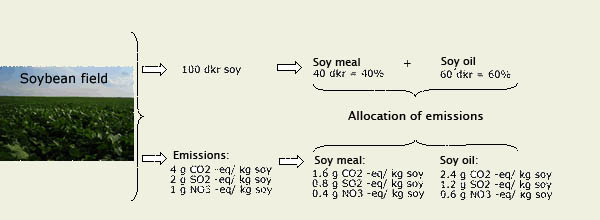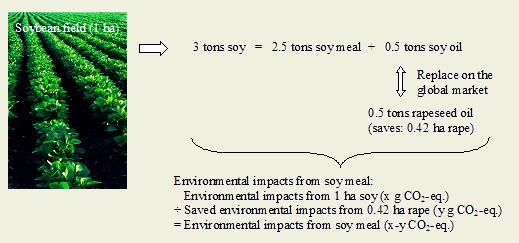System expansion and allocation
In many processes more than one product is produced (joint production), in such cases it is necessary to divide the environmental impacts from the process between the products. It is not straightforward to divide environmental impacts between the product and the co-product, but with help from allocation or system expansion it can be done. The choice between the two methods can have huge impacts on the result of the LCA. The ISO 14040-series suggest using system expansion whenever possible and where it is not possible to use system expansion allocation can be used instead.
Allocation of environmental impacts between the product and co-products can for example be performed from an economic or weight point of view. Allocation is a division of the environmental impacts according to how much the products costs/weights, e.g. if a product costs 60dkr and the co-product costs 40dkr, then the product is said to give 60% of the environmental impacts and the co-product 40% of the environmental impacts. The weight allocation is performed in the same way, just with weight data. In Figure 13 a sketch of an economic allocation can be seen.

Figure 13. Example of allocation. eq. = equivalents
In system expansion co-products are considered alternatives to other products on the global market as shown in the following example.
At a pig farm pork is the main product and manure is produced as a co-product. In such a production it is not possible to allocate precisely what feed use, land use, emissions etc. are related to for example pork vs. manure and therefore system expansion must be used. The manure production replaces fertilizer on the market, which means that there is an avoided production of fertilizer and thereby a negative contribution to the environmental impact from the lifecycle of pork. In this example the system is then expanded to include the system of processes, which are involved in fertilizer production. See a sketch of system expansion in Figure 14.

Figure 14. Example of system expansion. eq. = equivalents
Identification of the marginal product can be made through a marginal line of thinking, where the avoided product is a marginal product, which is the product that will be used more of if the production of the co-product decreases. Thorough the crediting the main product forms a system of products and avoided products.
Another example where system expansion is necessary is in flour. Grains are processed into flour and bran during the milling process. The environmental emissions associated with flour are determined by summarizing the total emissions associated with the milling process and subtracting the total emissions associated with the product that the marginal bran displaces in the market. Marginal bran is used for animal feed and is assumed to displace spring barley. Hence, the system of processes involved in analysis of flour is expanded to include the system of processes which are involved in spring barley production and the total emissions associated with flour is determined by subtracting the emissions associated with saved spring barley production from the emissions associated with flour and bran production.
The two methods for dividing the environmental impacts between the main product and co-product (allocation and system expansion) is part of two methods for making LCAs. Allocation is part of the traditional attributional method. Attributional LCA seeks only to cut the piece of the global environmental impact related to the product. The goal is to describe the environmental relevant physical flow. Average suppliers data are used. System expansion is part of the consequential LCA method that seeks to capture change in environmental impact as a consequence of a certain activity and there by generate information on consequences of actions. Marginal data is used.